Now is the time to see the therapist, whether you’re on a surfboard or a trail.

On a Wednesday morning, nearly a dozen women gathered on Santa Monica beach.
Their routine was consistent: They’d do a grounding exercise and focus on the present moment before pulling on their wetsuits and grabbing surfboards, heading into the water to face whatever the ocean brought them that day.
“The water is different every week and you’re different every week,” said Elizabeth Sale, one of the participants in Surf Sister Sessions, a surf therapy program run by Groundswell Community Project. “No matter what was going on in my work, I could show up, I could share and feel the sort of communal connective tissue.”
Surf Sister Sessions explore themes such as mindfulness, gratitude, self-identity and trauma recovery.
(Francine Orr / Los Angeles Times)
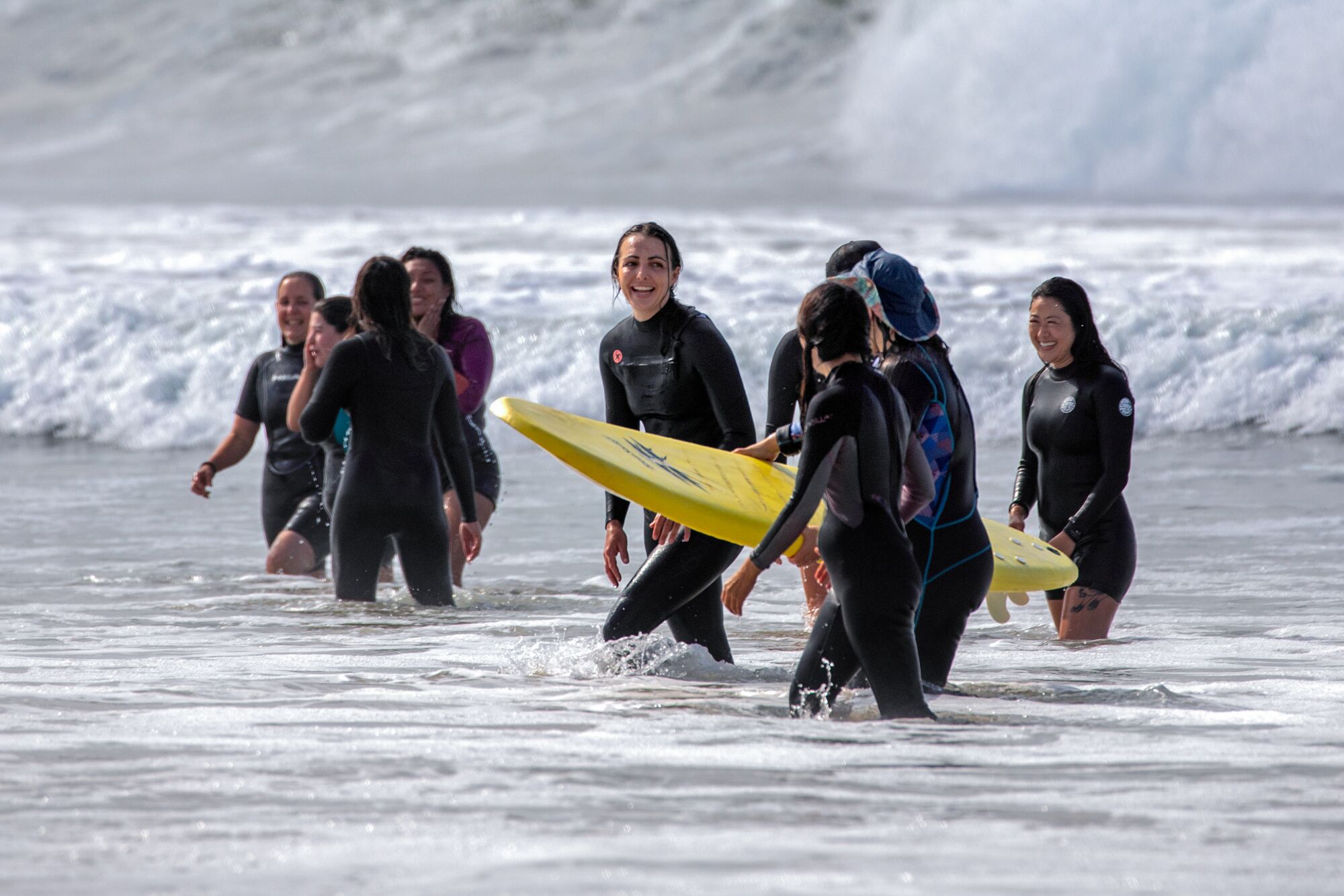
After a surf therapy session, participants walk to shore.
(Francine Orr / Los Angeles Times)
Led by a licensed therapist and a surf therapy facilitator, the surf sessions are just one of the many therapy programs that now blend talk therapy with physical activities to help people process. Across the country, you can find everything from dog walking therapy to horticulture therapy to improv therapy.
The idea that our bodies can reflect and store emotions and trauma is not new — the 2014 book “The Body Keeps the Score” by psychiatrist Bessel van der Kolk has spent years atop the New York Times best-seller list, and it has long been believed that hip-opening exercises can help release emotions and trauma. But these spaces that fuse therapeutic practices with a physical activity are ever-expanding, reaching new clients who might find sitting face to face in a formal office intimidating or who want to explore how movement can challenge them to process emotions differently.
Daniel Gaines, a therapist based in Los Feliz, started offering walking sessions after the restlessness of the pandemic set in.
“When I started doing virtual sessions I enjoyed it, but at the same time, it felt kind of stuffy,” Gaines said. “I just was like, ‘You know what? There’s a beautiful trail just down the street. Let me try that.’”
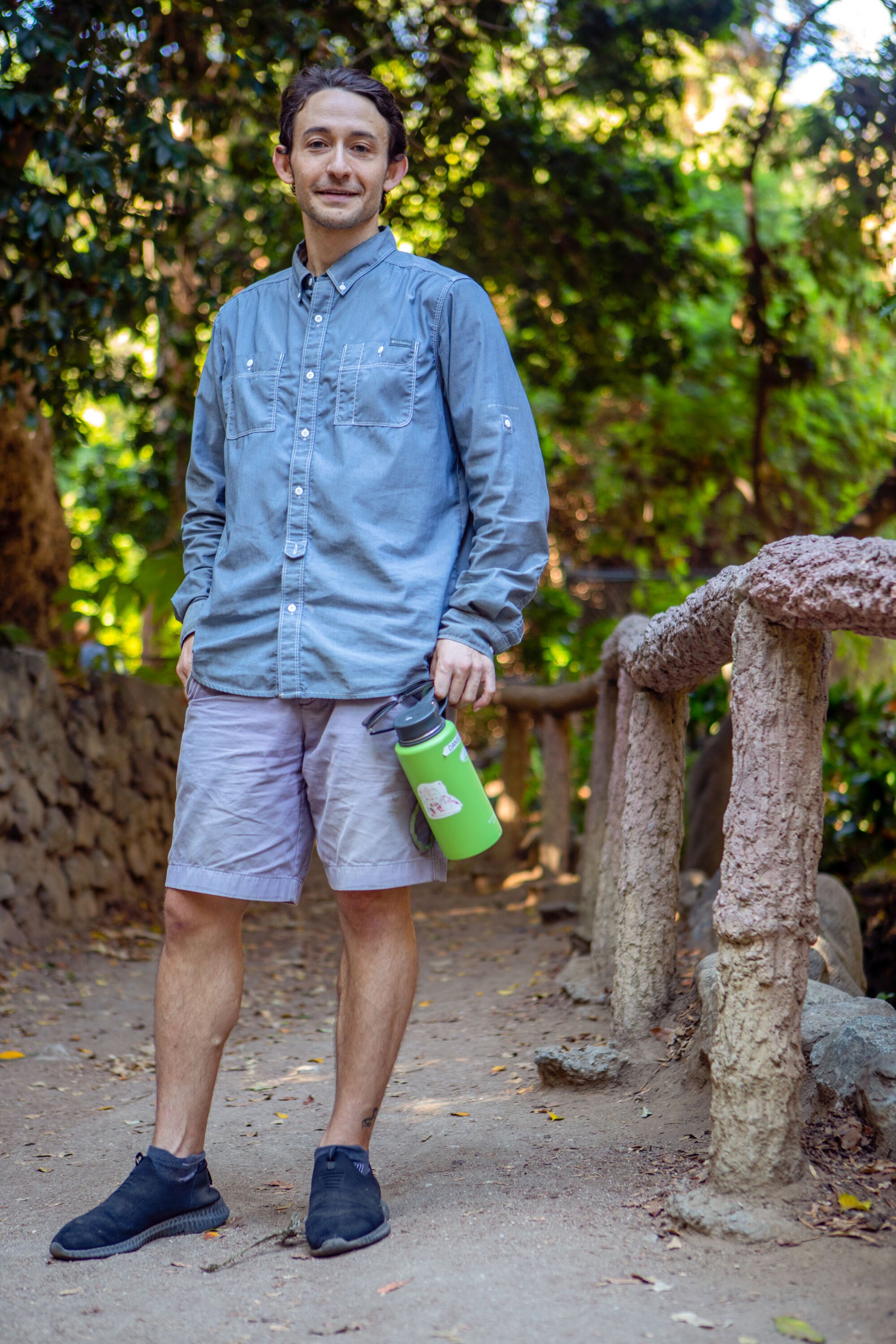
Daniel Gaines is a hiking therapist who takes some of his clients to Ferndell nature trail in Griffith Park.
(Francine Orr / Los Angeles Times)
Taking many of his clients on an hour-long loop through Griffith Park, Gaines said he first got the idea in graduate school and reached out to Amanda Stemen, another local therapist who often takes her clients through Kenneth Hahn State Recreation Area.
“With the freedom of movement comes this sort of freedom to really wonder and consider possibilities in your life that you hadn’t thought of,” Gaines said. “I just feel like it really contributes to the flow of ideas and the flow of conversation.”
Part of this is from his own experiences — Gaines said he likes to walk while he’s talking with his own therapist — but there are also clear benefits to getting out of the house or office. He mentioned many studies have shown that spending time outside in nature can help with anything from ADHD and post-traumatic stress disorder to depression and anxiety.
“It’s not like it makes all your problems melt away,” he added. “But I feel like it gives people this sense of this, like, ‘Oh, yeah, there’s a big world out here.’ And it can sort of help put things in perspective.”
Leah, a Groundswell surf facilitator who asked to be identified by her first name to protect her privacy, initially found Groundswell while she was working with another local collective called Black Girls Surf.
“[Groundswell was] talking about mental health in a way that felt, for me, very emotional,” Leah said. “In my community, we’re not necessarily focused on emotions — it’s more tough love. And so I was very intrigued. I was like, ‘Hmm. What if I started seeing myself with more compassion and treating people around me with more compassion?”
Soon enough, she was hired as one of Groundswell’s surf facilitators, where she guides new and nervous surfers through the water. A native of Hawaii who moved to Southern California after college, Leah said she was similarly anxious when she started surfing in L.A.
“When I first put my wetsuit on it took me like 30 minutes — I was shaking,” Leah said. “You’re maybe one of the only people of color on the beach and you have to put your wetsuit on and then you have to tell yourself, ‘I’m going to go out on the waves and do it.’”
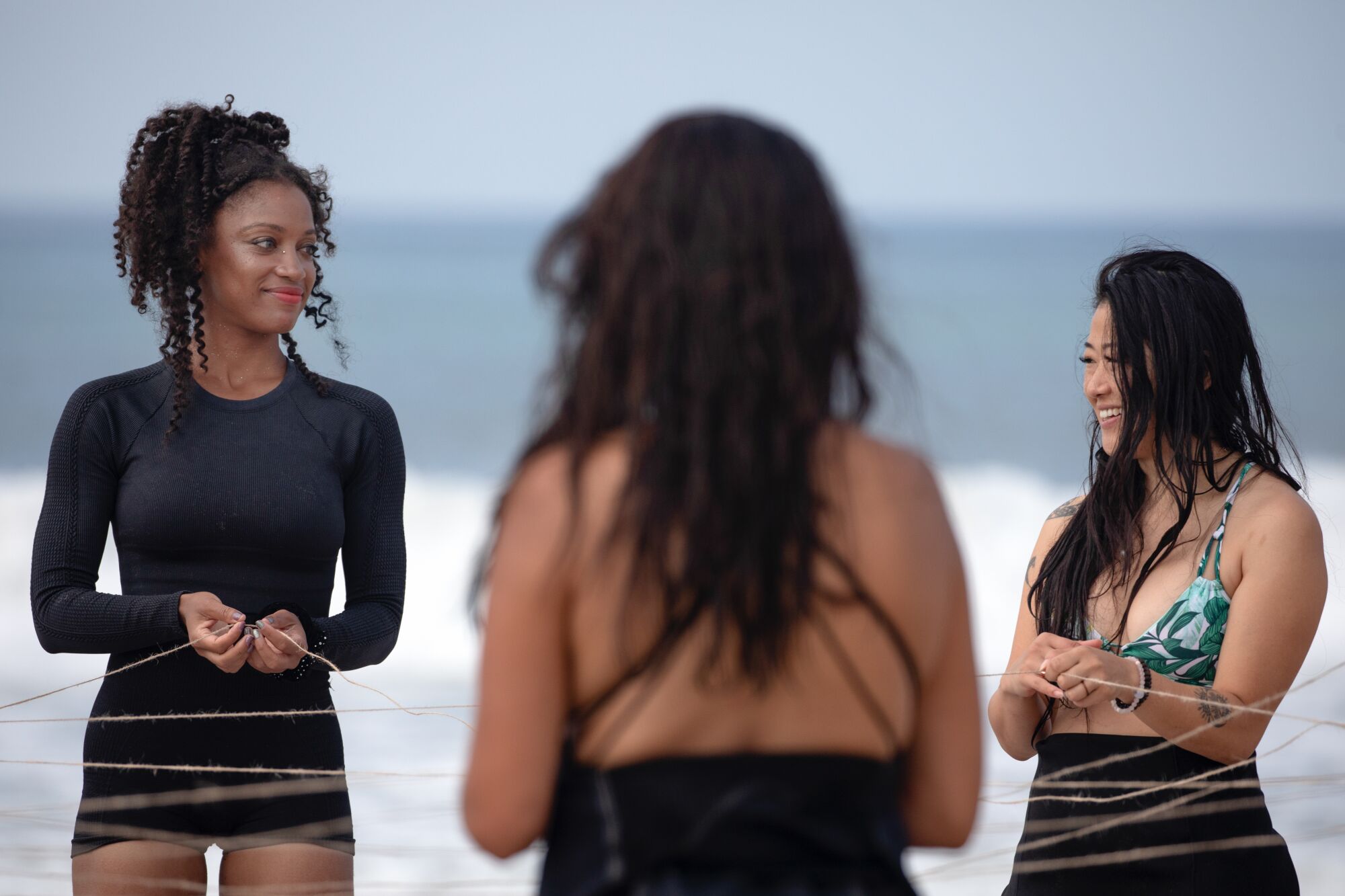
Leah, left, and Ali, right, who wish to be identified by their first names, attend Groundswell’s surf therapy program.
(Francine Orr / Los Angeles Times)
But the benefits of getting into the water, she said, often outweighs people’s initial fears.
“The main thing that I’ve noticed is that when they’re on land, in the very beginning, they’re one way, but then when they go into water they’re laughing and smiling,” Leah said.
Ai, another member of the group, who asked to be identified by her first name to protect her privacy, said that the group helped her work through some long-lasting trauma and anxiety.
“I’ve been in therapy for a decade,” she said. “And this definitely feels different from just regular talk therapy. It’s a lot less like, ‘let’s analyze your head.’ It’s more like meditation.”
When Vicki Alvarez and Clorinda Rossi-Shewan each discovered dance therapy through working with Kathy Cass and Hilary Kern through their Chance to Dance and Dance For All programs, they felt similarly enamored with the way movement could help people express themselves.
By 2018, Alvarez, who is now a registered dance movement therapist, and Rossi-Shewan, who’s a licensed marriage and family therapist, took the lead on training others in the Dance For All curriculum and rebranded its signature class as Let’s Dance It Out for special needs teens and adults. Though the class isn’t quite therapy, Alvarez said that the activities they practice draw from what they have learned in their individual therapy practices.
“How can I identify this feeling that’s coming up in my body, that’s not always easy to say out loud or to verbalize?” she said. “I can show this emotion through my body, and then have somebody else witness that. We can have these feelings and just coexist in this space and move through things together.”
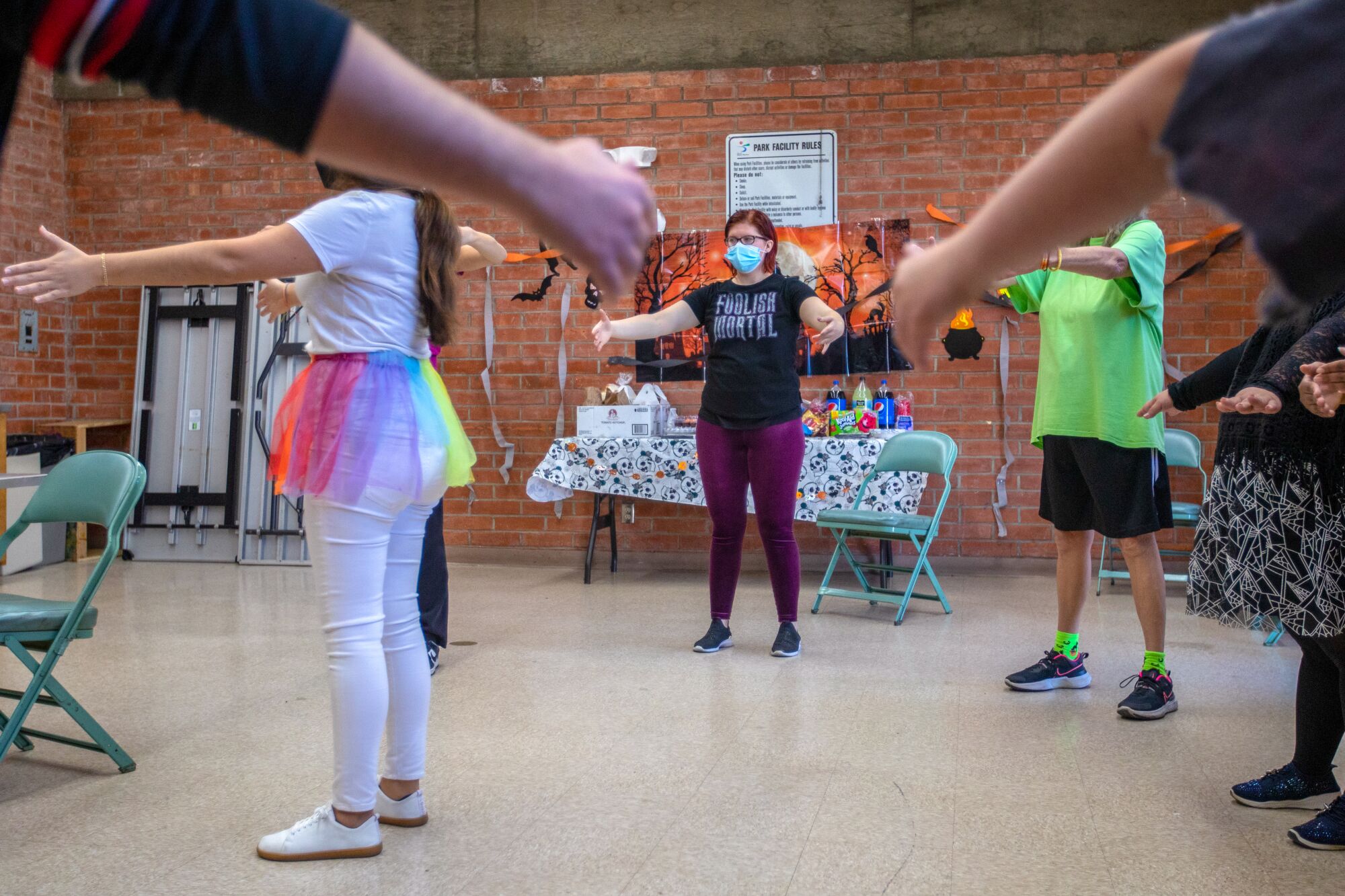
Rachel Symons, center, dances with students during the Let’s Dance It Out class in Santa Monica. The program aims to build social, emotional and cognitive skills using the power of movement.
(Francine Orr / Los Angeles Times)
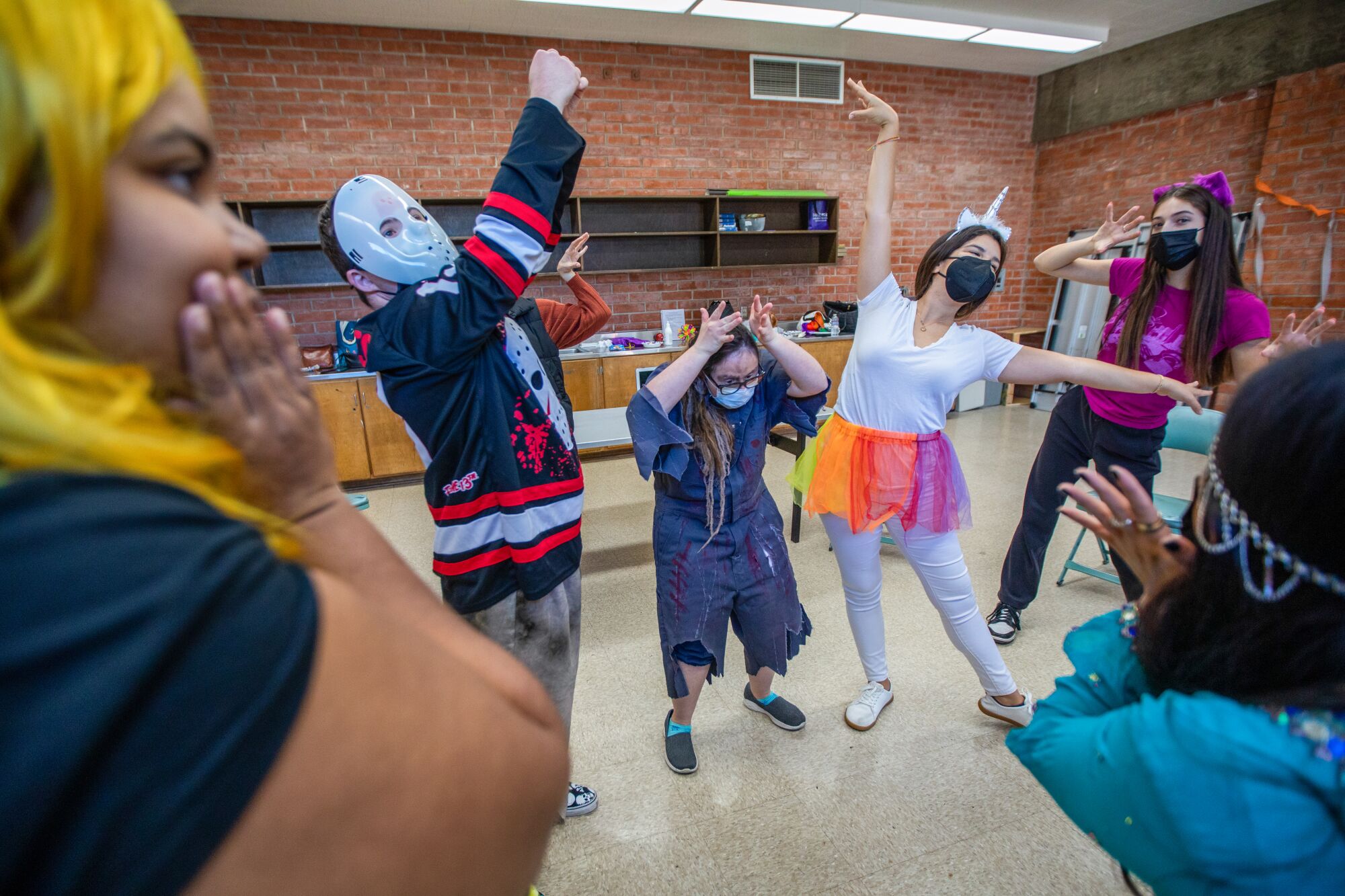
Let’s Dance It Out participants have called the class “healing.”
(Francine Orr / Los Angeles Times)
Kellie McKuen, one of the dancers in the class, said that she first joined Let’s Dance It Out when it was called Chance to Dance about 20 years ago.
“As a woman who’s 60 now and on the autism spectrum, it was different when I was a kid,” McKuen said. “I really didn’t get the opportunity [to dance] because the kids were pretty mean.”
But once she found this space to dance and express herself, she just wanted to keep coming back. She said that even just offering the other dancers room to express whatever’s on their mind can feel healing in itself.
“Some people come in and have been nonverbal and shy and didn’t really want to get up and dance,” McKuen said. “And then I’m telling you, like two or three years later they’re stealing the scenes.”
“It’s like yes!” she continued. “All you needed was just the opportunity and some patience and look what blossomed.”




